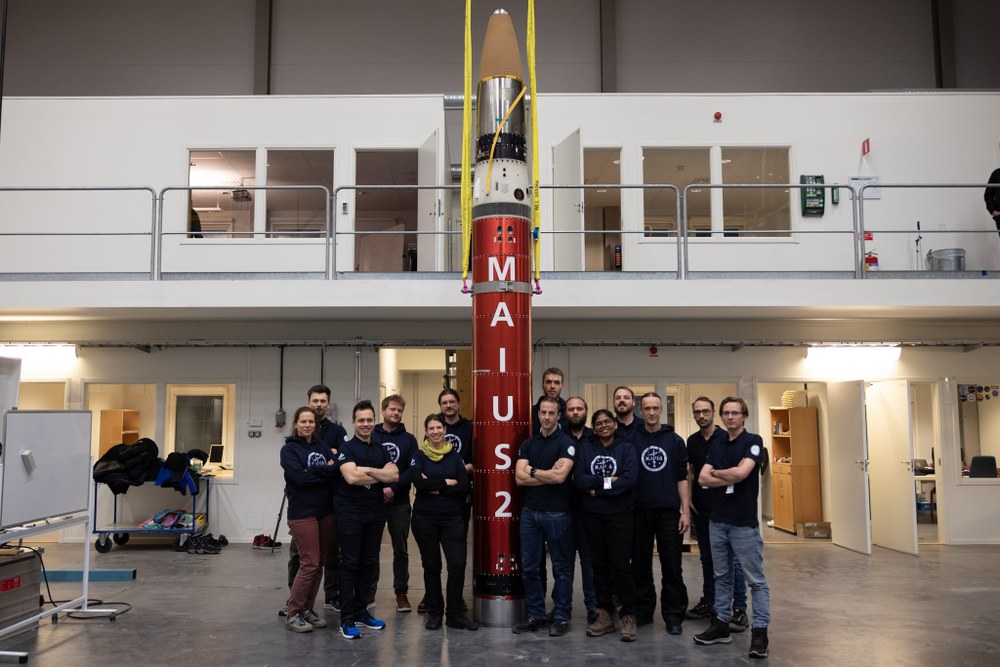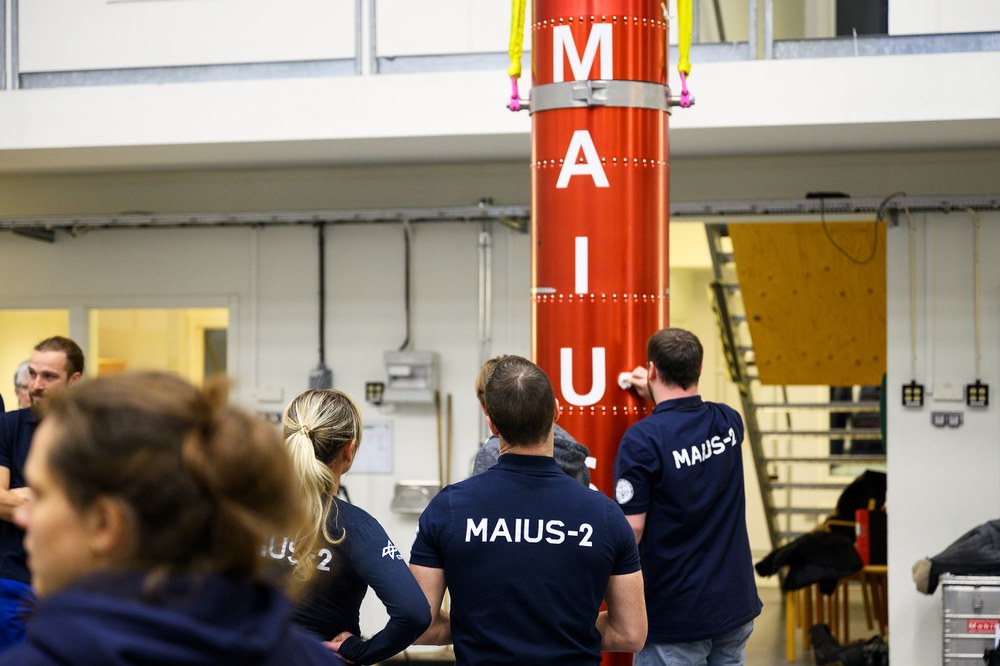MAIUS 2 – ultracold atoms in a space mini-laboratory


- On 2 November 2023 at 8:30 CET, the MAIUS 2 experiment was launched on a research rocket from the Esrange Space Center near Kiruna in northern Sweden.
- The experiment investigated the generation and interaction of Bose-Einstein condensate mixtures in microgravity.
- A Bose-Einstein Condensate (BEC) is a state of matter formed at temperatures close to absolute zero, where a group of atoms occupy the same quantum state, exhibiting unique quantum effects.
- Miniaturising this technology is intended to advance the development of the US-German Bose Einstein Condensate and Cold Atom Laboratory (BECCAL).
- Focus: spaceflight, quantum research, research under space conditions
Technology has to be small, light and thoroughly tested if scientists are to conduct research with it on the International Space Station ISS. However, some experiments are so complex that miniaturisation is a major challenge. These include experiments with so-called Bose-Einstein Condensates (BECs), in which ultracold atoms 'vibrate in unison' in what's called a matter wave. To further advance this field, the Matter-Wave Interferometry in Microgravity (Materiewellen Interferometrie unter Schwerelosigkeit; MAIUS 2) experiment was launched on 2 November 2023 at 8:30 CET, aboard a sounding rocket that lifted off from the Esrange Space Center near Kiruna in northern Sweden. During the almost six-minute period of microgravity, German researchers succeeded for the first time in producing two mixtures of BECs simultaneously during a high-altitude rocket flight, studying their behaviour under conditions not possible in ground-based observatories.
"MAIUS-2 is the most complex experiment we have ever carried out on a sounding rocket. We were able to prove that the increasingly miniaturised technology works in principle in space," explains Rebekka Grellmann, MAIUS project manager at the German Space Agency at DLR. During the flight, the generation of rubidium Bose-Einstein condensates was demonstrated and their behaviour in free fall was investigated. The researchers were also able to examine the generation and behaviour of cold 'atomic clouds' during the rocket's burn time. However, the Bose-Einstein condensate of potassium atoms did not form as planned. "But we have already learned a lot from the mixtures generated on the ground," continues Grellmann. "NASA is already conducting research with its Cold Atom Lab on the ISS. In the future, however, an improved laboratory will be installed there to enhance research into ultracold and condensed mixtures and contribute to the development of future quantum sensors, for example with in-depth research on ultracold and condensed atoms. The results of the MAIUS flight and from the laboratory are now being closely examined so that this US-German atomic laboratory – the Bose Einstein Condensate and Cold Atom Laboratory (BECCAL) – can be further advanced."
While Bose-Einstein condensates can only be maintained for fractions of a second under normal gravity, the sounding rocket provided approximately six minutes of microgravity. During this time, 75 experiments were carried out largely autonomously on board the rocket. The production of Bose-Einstein condensates, especially mixtures, is extremely complex and requires finely-tuned experimental parameters. These have to be determined at the beginning of the microgravity phase, as they differ from the parameters on the ground. Following the successful creation of ultracold mixtures of rubidium and potassium, the 'ground state' of their wave function in microgravity will be analysed, using the data obtained during the flight. Different types of atoms mix differently in microgravity than they do on the ground (like water and oil), due to the lack of buoyancy (the upward force exerted by water or air).
Two types of atoms – many experimental and technological challenges
In addition to ultracold rubidium atoms, MAIUS 2 was the first time a sounding rocket flew ultracold potassium atoms. However, the use of two different types of atoms presented a major technological challenge for the team. Generating BECs with two different types of atoms requires twice the number of lasers and therefore more electronics – which means a more complex payload is needed with an almost unchanged mass and volume possible for the apparatus. In addition to the technological challenges, there were also experimental challenges, as the generation of these mixtures is far from trivial. So how can a BEC be created in such a small device?
Atoms in a trap
To create a Bose-Einstein Condensate, the movement of atoms must be dramatically minimised. To do this, the clouds of rubidium and potassium atoms must be cooled to almost minus 273 degrees Celsius – just a fraction of a degree above absolute zero, the coldest temperature possible in the Universe. In a two-stage process, the atoms are first slowed down using miniature lasers – the faster an atom moves, the higher its temperature. Laser pulses slow down the atoms, extracting energy from them. However, this principle of 'laser cooling' can never completely slow them down. This technique alone is not sufficient to bring them close enough to absolute zero.
Energy is simply 'blown away'
Following laser cooling, the second phase of temperature reduction begins in a 'magnetic trap', from which the atoms cannot escape. The trap, an 'atom chip', is a device in which magnetic fields confine and can manipulate cold atoms. The magnetic confinement can be thought of like the trap's 'walls'. The fastest atoms are then selectively removed with the help of microwaves, leaving behind a cloud of atoms that are on average colder than before. This method is comparable to cooling coffee in a cup. If the hot drink is left to stand, it cools relatively slowly. However, if the rising vapour – the remaining energetic gas atoms – is removed by blowing, the hot drink cools down much more quickly.
This evaporative cooling makes it possible to reach temperatures just a breath away from absolute zero – ideal conditions for observing a BEC. The resulting ultracold atoms can then be studied, to understand their ground state – their state of lowest energy – and interactions, and also provide ideal conditions for matter-wave interferometry.
Further experiments will follow with cold atoms and interferometers in space
To achieve previously unattainable accuracy with space-based atomic interferometers, more detailed studies of the dynamics and interactions of Bose-Einstein Condensate mixtures will be important on board future rocket experiments and missions to the ISS or on satellites. BECCAL will then be used to interferometrically compare the fall velocities of BECs from both types of atoms. This will be used to test the part of Einstein's theory of relativity that states that all masses fall at the same rate in a vacuum, known as the equivalence principle. If this hypothesis was to be disproved, the theory of relativity would no longer be fully valid.
Software for research at absolute zero
The DLR Institute for Software Technology, together with the DLR Institute for Satellite Geodesy and Inertial Sensing, provided the software for both the preparation and the execution of the MAIUS-2 cold atom experiments. With the help of specially developed programs, physicists were able to transfer the individual experiment sequences to the onboard computer without in-depth programming knowledge. During the experiment itself, the flight software on the onboard computer was responsible for a variety of tasks. It configured and executed the experiment sequences, collected, stored and transmitted data to ground stations and controlled special hardware components such as cameras during the flight.
No rocket, no research
The Mobile Rocket Base (MORABA) of DLR's Space Operations and Astronaut Training facility was responsible for carrying out the MAIUS-2 launch. In addition to the rocket systems, this also included payload support systems, for example for attitude control during the microgravity phase and recovery at the end of the flight, as well as the rocket's own support systems.
A mission made possible by a German research consortium
The MAIUS-2 project is coordinated by the German Space Agency at DLR with funding from the Federal Ministry for Economic Affairs and Climate Action (BMWK). The MAIUS-2 consortium is led by the University of Bremen. Leibniz University Hannover is the scientific leader in cooperation with Humboldt Universität zu Berlin and the Ferdinand-Braun-Institut in Berlin, the Center of Applied Space Technology and Microgravity (ZARM) at the University of Bremen, Johannes Gutenberg University Mainz, Universität Hamburg, Ulm University and the Technical University of Darmstadt. The research consortium also includes the DLR Institute of Space Systems in Bremen, the DLR Facility for Simulation and Software Technology in Braunschweig, and the DLR Mobile Rocket Base (MORABA), which was responsible for conducting the launch campaign.
Since 2004, the German Space Agency at DLR has been funding the generation and matter-wave interferometry of Bose-Einstein Condensates (BECs) under microgravity conditions as part of the QUANTUS collaborative projects. As part of this programme, the QUANTUS team succeeded for the first time in 2007 in generating a BEC under microgravity conditions in the ZARM drop tower in Bremen. The research with QUANTUS, which has attracted worldwide attention, provided decisive pioneering work for MAIUS and the Cold Atom Laboratory (CAL). QUANTUS continues to be an important pioneer in the preparation of further missions, such as BECCAL and the European pathfinder mission for gravity field measurements, CARIOQA, both in the drop tower and on sounding rockets.


